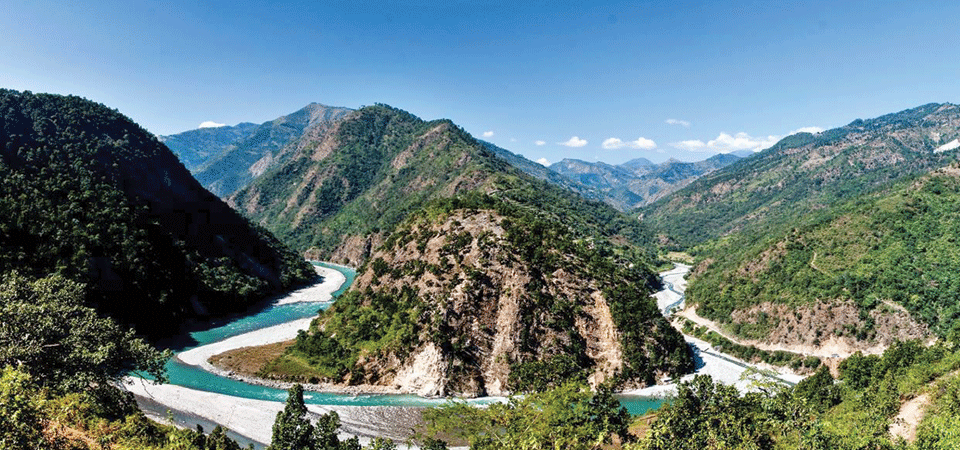NEA moving forward large reservoir and semi-reservoir hydropower projects

By A Staff Reporter, Kathmandu, Sept. 4: Nepal Electricity Authority (NEA) has given priority to the construction of the large reservoir and semi-reservoir hydropower projects to balance the country's electricity demand and supply.
NEA is planning to forward the construction of the 835 MW Dudhkoshi reservoir, 1,061 MW Upper Arun and 210 MW Chainpur Seti semi-reservoir hydropower projects.
Detailed studies of all three projects are now at the final stage. NEA Managing Director Kul Man Ghising said that the detailed engineering of the three hydropower projects had been finalised, tender documents for the construction of contractors had been prepared, access roads, land acquisition, discussions with local financial institutions and international donors for financial management had been taken forward.
"The construction of reservoir-based and semi-reservoir-based projects are given high priority to balance the daily and seasonal demand and supply, and export of surplus electricity to neighbouring countries," Ghising said. "We are working hard to complete all the preconstruction works within a year and begin their construction works shortly after."
Ghising said discussions were underway with the European Investment Bank (EIB), Asian Infrastructure Investment Bank (AIIB) and the Korean Exim Bank for investment in the Dudhkoshi, bankrolled by the Asian Development Bank (ADB) through the Ministry of Finance. "We will raise money by issuing shares to the general public under Nepal's Water, People's Investment programme implemented by the government. The return from the project will reach the citizen level," he said.
The investment for Upper Arun and Chainpur Seti will be mobilised by issuing shares to the general public through the programme. The estimated base cost of Dudhkoshi is US$ 1.53 billion (approximately Rs. 178 billion) and the total cost, including interest for the construction period and taxes, is estimated at around US$ 2 billion. Among the studied reservoir projects, Dudhkoshi is considered to be relatively cheap and attractive in terms of cost and energy production.
The study has shown that out of 3.44 billion units of energy generated annually from the projects which fall in Khotang, Okhaldhunga and Solukhumbu districts, 1.36 billion and 2.8 billion units of energy will be generated in the winter and the rainy season respectively. The project has already issued a public notice for the construction of access road and acquisition of about 13,000 ropanis of land in Khotang in the flooded area above the dam construction site.
The process of land acquisition in Okhaldhunga and Solukhumbu will start soon. The construction of the project is estimated to take seven years. The generated electricity will be connected to the national grid through the proposed Sunkoshi-Dhalkebar 400 kV transmission line. Ghising said that the semi-reservoir Upper Arun would be given high priority and would be promoted as a 'game changer' project.
Under the People's Hydropower Programme, the four-digit capacity of the project (1061 MW) and the largest ever project being constructed by the NEA, the public will have 49 per cent of the total share, concessional loan of financial institutions such as World Bank and European Investment Bank and investment from domestic financial instructional, Employees Provident Fund, Citizens Investment Fund.
The federal, provincial and local governments will also invest in the project. The estimated cost of the project is about 1.2 billion excluding interest during the construction period. NEA plans to raise 30 per cent of the total cost from equity and 70 per cent from loans.
The project will generate 4.53 billion units of energy annually. NEA has moved ahead with the 30 MW Ikhuwa Hydropower Project to be a part of Upper Arun.
Chainpur Seti in Bajhang will be promoted as a game-changer project in the far western region. The federal, provincial and local governments, the project affected and the general public across the country will invest in the project to be constructed under the People's Hydropower Programme.
Tender documents are being prepared for the construction of the project in engineering, procurement and construction (EPC) model, construction of access road, land acquisition and other works.
Recent News

Do not make expressions casting dout on election: EC
14 Apr, 2022
CM Bhatta says may New Year 2079 BS inspire positive thinking
14 Apr, 2022
Three new cases, 44 recoveries in 24 hours
14 Apr, 2022
689 climbers of 84 teams so far acquire permits for climbing various peaks this spring season
14 Apr, 2022
How the rising cost of living crisis is impacting Nepal
14 Apr, 2022
US military confirms an interstellar meteor collided with Earth
14 Apr, 2022
Valneva Covid vaccine approved for use in UK
14 Apr, 2022
Chair Prachanda highlights need of unity among Maoist, Communist forces
14 Apr, 2022
Ranbir Kapoor and Alia Bhatt: Bollywood toasts star couple on wedding
14 Apr, 2022
President Bhandari confers decorations (Photo Feature)
14 Apr, 2022











